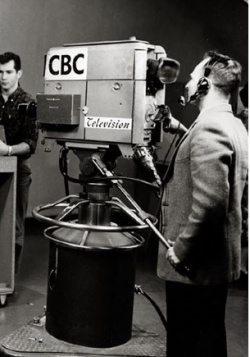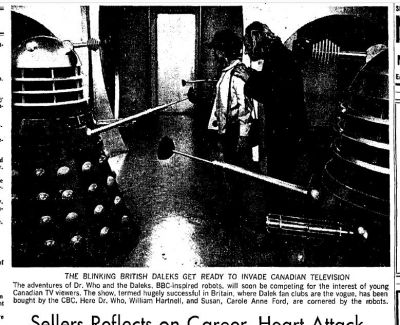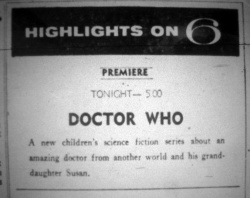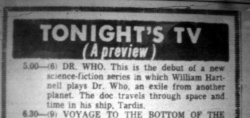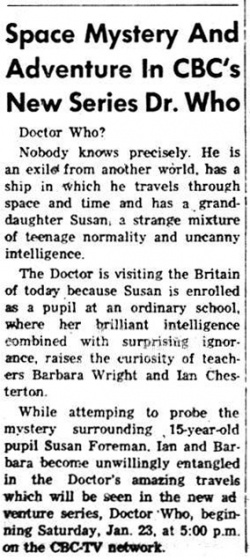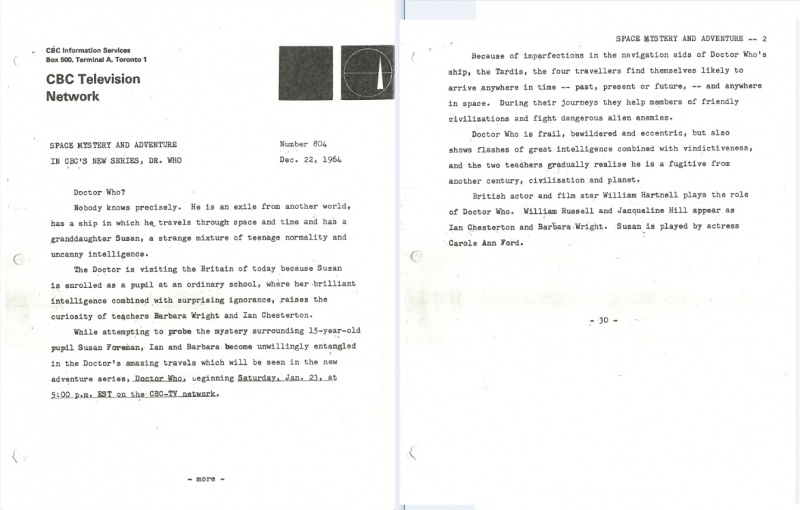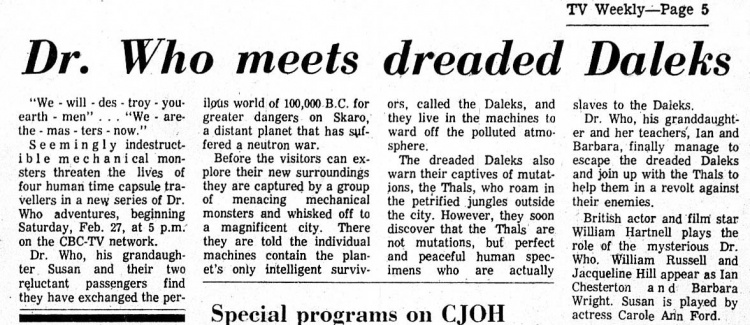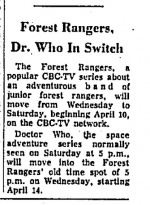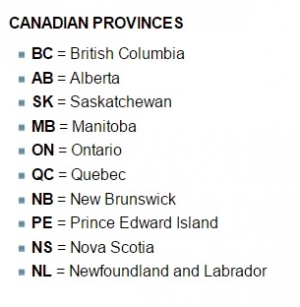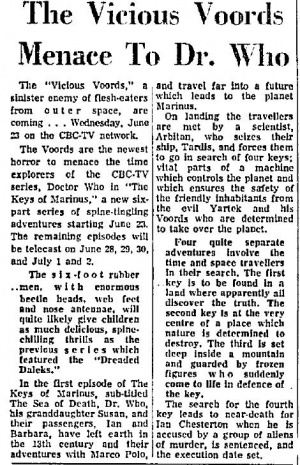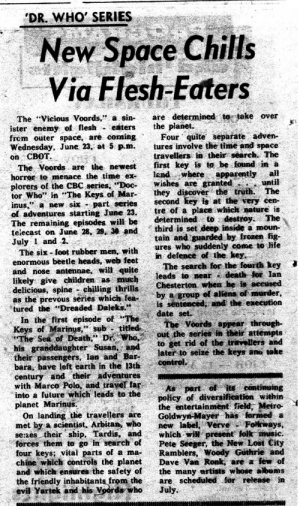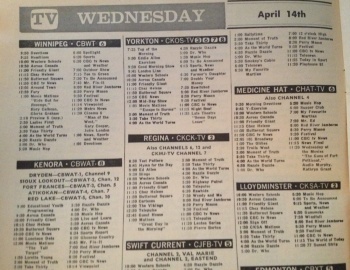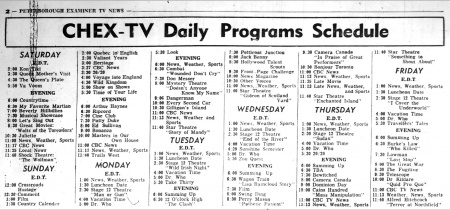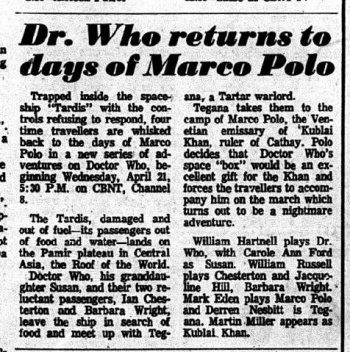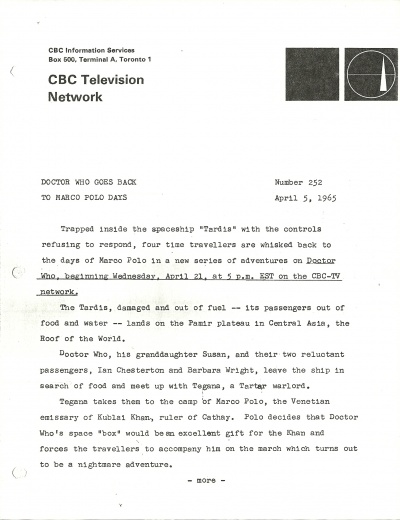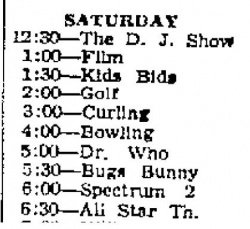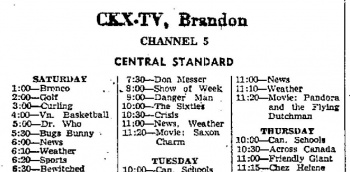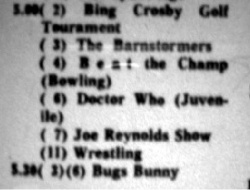Difference between revisions of "CBC"
Jon Preddle (talk | contribs) |
Jon Preddle (talk | contribs) |
||
| (18 intermediate revisions by the same user not shown) | |||
| Line 2: | Line 2: | ||
{{TOC right}} | {{TOC right}} | ||
==Channel Profile== | ==Channel Profile== | ||
| − | [[File: | + | [[File:CBCCamera.jpg|right|thumb|250px]] |
| − | + | The '''[[wikipedia: Canadian Broadcasting Corporation|CANADIAN BROADCASTING CORPORATION (CBC)]]''' is the public broadcaster of [[Canada]]. The first regional television broadcasts were transmitted from Montreal (station CBFT) on '''6 September 1952''' and then from Toronto (station CBLT) two days later, on '''8 September 1952'''. (The live broadcast of the official opening ceremony in Toronto was directed by a gentleman named Sydney Newman!) | |
| − | [[ | + | |
| − | [[ | + | In less than a decade service stretched from the Atlantic coast to the Pacific coast. A major milestone was achieved in 1958 with the completion of the national microwave relay network providing live CBC network feeds from coast to coast. |
| − | + | ||
| − | + | '''Doctor Who''' commenced on the CBC network in '''January 1965'''. | |
| − | |||
| − | |||
| − | |||
| − | |||
| − | |||
| − | |||
| − | |||
| − | |||
| − | |||
| − | |||
| − | |||
| − | |||
| − | |||
| − | |||
| − | + | Unlike other public broadcasters, the CBC television network of 1965 included transmitters owned and operated by the CBC (usually the larger cities) along with transmitters owned by private firms that operate under an affiliation agreement with the CBC (usually the smaller centers). Affiliates are required to carry a minimum amount of network programming but are otherwise free to set their own programme schedules and potentially decline to carry some CBC programmes. | |
| − | + | Due to its size, Canada stretches across 6 time zones; making television distribution a very complicated affair resulting in a significant amount of regional variation. The English language programming hub for the network is station CBLT in Toronto. For the western provinces a time-shifting operation is employed to videotape the Toronto feed for playback at the desired local time a few hours later. For the west this was mainly achieved by the Calgary Delay Centre with its bank of VTR machines along with the videotape centre at CBWT Winnipeg. | |
| − | + | The Atlantic Provinces (Nova Scotia, New Brunswick, Prince Edward Island, Newfoundland and Labrador) lie to the east of Ontario and Quebec (Eastern Time Zone) and thus are ahead in time. In 1965 there was no facility for an overnight pre-release of programmes to the Atlantic Provinces for a videotape time-shifting operation. This had to wait for the launch of the Halifax Videotape Centre on 15 September 1968. Until then, Atlantic Canada had to accept a time zone shift for most programming. | |
| − | + | However, [[Atlantic Canada]] flagship station CBHT Halifax did perform a programme delay operation for the weekday 3 PM to 6 PM programming block. The Toronto 3 PM to 6 PM weekday schedule includes panel shows, daytime dramas and after-school youth programmes and this weekday afternoon block had to be time-shifted by CBHT Halifax or else it would extend past 6 PM, the normal time for the start of local supper-hour newscasts. The solution was to make 16 mm film recordings ('''[[Kinescopes Canada|kinescopes or kines]]''') of the Toronto feed and have Halifax play it back a week later at the desired local time and relay the signal to all of [[Atlantic Canada]]. Hence, when '''Doctor Who''' moved to Wednesday afternoons in Canada it was seen in [[Atlantic Canada]] via kinescopes with a network delay of one week relative to Toronto. | |
| − | + | The term "kinescope" for a film recording of a TV broadcast is chiefly used in North America. In Britain and many other nations the term "telerecording" is used instead. | |
| − | + | Although Canada had an extensive microwave relay network for TV carriage, it did not reach everywhere. A number of smaller stations in Northern British Columbia, Northern Manitoba and Labrador had to rely on a package of kinescope films that were shipped from station to station via a bicycle system. The fate of the kinescope recordings as well as the BBC supplied prints is of obvious interest. | |
| − | + | {{clear}} | |
==Stories bought and broadcast== | ==Stories bought and broadcast== | ||
| − | + | [[File:Daleks31-10-64.JPG|right|thumb|400px|"Blinking British Daleks" - Toronto's Globe and Mail, 31 October 1964]] | |
===[[William Hartnell stories|WILLIAM HARTNELL]]=== | ===[[William Hartnell stories|WILLIAM HARTNELL]]=== | ||
| + | [[File:CBC CH6.JPG|thumb|right|250px|PREMIERE; Toronto Globe & Mail, 23 January 1965]] | ||
| + | [[File:CBC TV.JPG|thumb|right|250px|TONIGHT'S TV; Toronto Daily Star, 23 January 1965]] | ||
| + | [[File:DWStartsCBC.jpg|right|thumb|250px|CBC's New Series Dr. Who starts; Peace River Block News (Dawson Creek), 20 January 1965]] | ||
Five stories, 26 episodes: | Five stories, 26 episodes: | ||
| Line 57: | Line 46: | ||
CBC therefore bought GROUP A of the [[William Hartnell stories]]. | CBC therefore bought GROUP A of the [[William Hartnell stories]]. | ||
| + | |||
| + | Toronto's ''Globe and Mail'' announced the purchase in its '''29 October 1964''' issue, stating that "twenty-six episodes" of the "51-part serial" [sic] had been sold to the CBC, and "will be shown in Canada shortly". (A week earlier, on 20 October, producer Verity Lambert and the main cast had been photographed together at the BBC lounge celebrating the first overseas sales of the programme.) | ||
| + | |||
| + | Two days later, the '''31 October''' issue featured a photo from the second serial, announcing that '''"THE BLINKING BRITISH DALEKS GET READY TO INVADE CANADIAN TELEVISION"'''. | ||
| + | |||
| + | The broadcaster paid '''£331 2'6''' (pre-decimal Sterling) for each of the 26 episodes. | ||
The programme was supplied as 16mm black and white film prints with English soundtracks. | The programme was supplied as 16mm black and white film prints with English soundtracks. | ||
| − | + | The first episode was evaluated by technical staff on '''9 December 1964'''. The light levels for the film print were deemed too dark and "not suitable for telecasting", and a technical recommendation was given that "this show not be accepted". But clearly a subsequent evaluation was given a few weeks later, and the series was cleared for broadcast in January 1965. | |
| − | The | + | Sales paperwork shows that [[The Aztecs]] and [[The Sensorites]] had both been cleared for a sale to Canada at the same time as the above five serials, but those two were never formally purchased and did not air. |
| + | A BBC memo dated '''7 July 1965''' also records that the other serials up to and including [[The Crusade]] had also been offered to "Canada", but that "(so far) they have not been accepted". By the time that memo was circulated, the CBC had already dropped '''Doctor Who''' from the schedules. | ||
| − | + | (See our dedicated page which investigates the possible reasons why '''Doctor Who''' was [[CBC Dropped|dropped by the CBC in 1965]].) | |
| − | |||
| − | + | ====Origin of the Prints==== | |
| − | The | + | The CBC would have received a fresh set of telerecording (kinescope) prints from the BBC. BBC Enterprises had a sales office within one of the CBC office towers in Toronto (at 135 Maitland Street), and the films would likely have passed through that office before being dispatched to the CBC's headquarters also in Toronto. |
| − | + | Canada was the third country outside the UK to screen the series. It was the first to do so in a commercial operation where commercial breaks were added to the programme. (Although [[New Zealand]] was the first commercial country to screen '''Doctor Who''', there is sufficient evidence to indicate that no commercials were played during the programme at any time in the 1960s.) | |
| − | + | The duration of each broadcast was fixed at 30 minutes, a time slot that would include the actual programme, commercials, station ID, announcements, etc. Commercial insertion patterns for Canada in the 1960's were the same as that of the United States with usually two commercial breaks per 30 minute broadcast totalling up to about 5 minutes. Each commercial was typically one minute in length for that era. | |
| − | CBC | + | For Serials {{A}} to {{E}}, the run-times for this set of 26 episodes varied from 22:11 minutes to 26:34 minutes (episodes {{C}}2 and {{D}}2, respectively). It is not known whether the CBC had to cut down any of the '''Doctor Who''' episodes to shorten them to fit the 30 minute time slot with all the added inserts. |
| + | Since it's unlikely that the BBC would have supplied a print already edited for North American-style programming, that task would have fallen to the CBC to undertake, by either directly modifying the BBC prints or making duplicates, whether as film copies or videotape dubs, and editing that copy. If the CBC did edit the BBC print or a film copy of this print to add commercials it is possible (though on reflection highly unlikely) they shipped this out to the remote stations not connected to the microwave network instead of a kinescope recording of the Toronto broadcast. | ||
| − | + | (NOTE: The same commercials would have been played nationwide, since the sponsors' messages were inserted into the broadcast print that was then transmitted into the live microwave feed. Only the pre- and post- station idents would have differed, as they'd have been played in locally.) | |
| − | CBC | + | Taking all that into account, the most likely scenario -- and the most simplest – is that the CBC made any edits to the original films as supplied to them by the BBC, spliced into that same print all the commercials and 'blank' leaders for idents, and broadcast from that. The kines that were created from those broadcasts had the commercials 'printed in' as this was the standard pattern to prepare material for the remote stations. |
| − | {| {{small-table}} | + | [[File:CBC Press Release.jpg|left|thumb|800px|CBC press release dated 22 December 1964. The text from this appeared in various newspapers, such as the Peace River Block News above]] |
| − | !Station!!City!! | + | |
| + | <table> | ||
| + | <tr> | ||
| + | <td>[[File:DaleksPreview.jpg|thumb|right|750px|Daleks Preview; Ottawa Citizen, 27 Feb 1965]]</td> | ||
| + | </tr> | ||
| + | </table> | ||
| + | {{clear}} | ||
| + | |||
| + | =='''TV STATIONS'''== | ||
| + | |||
| + | ===Overview=== | ||
| + | |||
| + | The series premiered on the CBC microwave network on Saturday, '''23 January 1965'''. For most stations, air times were 5:00 PM but this varied considerably due to time zone shifts. The series continued on its Saturday slot for a total of 10 episodes. For stations employing a microwave (live) feed the Saturday episodes continued to '''3 April 1965''' at which point the series moved to Wednesdays from '''14 April 1965'''. | ||
| + | [[File:CBS Switch.JPG|thumb|right|150px|Change of date; Winnipeg Free Press, 18 April 1965]] | ||
| + | |||
| + | In moving to Wednesdays, '''Doctor Who''' swapped time slots with the popular '''[[wikipedia:The Forest Rangers|Forest Rangers]]''' programme. To coincide with the start of school vacation time, the series shifted to weekday screenings. For stations with a '''microwave (live) feed''' the final five episodes ran from Monday, '''28 June''' to Friday, '''2 July 1965'''. | ||
| + | |||
| + | For stations that utilize '''kinescopes''' (see the [[Kinescopes Canada|Kinescopes network]]) the start and end time for the series depended on the planned network delay for the kinescopes to arrive at the station via the bicycle system. With its one week delay for the last 16 episodes the series wrapped up on '''9 July 1965''' in Atlantic Canada. For station CBWBT Flin Flon in Manitoba the series ran through to '''16 July 1965'''. It is unclear when the series may have ended for station CFLA in Goose Bay, Labrador as the local newspaper ceased to carry television listings after 1 March 1965. If the series did continue in Goose Bay it would have likely ended in '''mid-August 1965'''! | ||
| + | |||
| + | Following the first run of the series it appears that stations in Saskatchewan aired repeats of '''Doctor Who''', possibly using kinescopes returned to Winnipeg from CBWBT Flin Flon. Station CFQC Saskatoon aired '''nine repeat''' episodes on weekdays starting '''5 July''' and ending '''16 July 1965'''. | ||
| + | |||
| + | |||
| + | ===List of CBC Stations=== | ||
| + | |||
| + | Of the following CBC stations, 47 of them aired '''Doctor Who''' in 1965. | ||
| + | |||
| + | Station call signs and ownership are current to 1965. Only stations with studio facilities are included. Unmanned signal repeater stations operating on a different channel used to extend the coverage of a studio station are not included. The list below summarizes the number of episodes aired by a station '''but does not include repeat episodes in the count''' (CFQC Saskatoon aired all 26 episodes then aired 9 repeat episodes). | ||
| + | [[File:CanadianProvinces.jpg|thumb|right]] | ||
| + | [[File:CANADA Voords.JPG|thumb|right|300px|Vicious Voords! Winnipeg Free Press, 13 June 1965]] | ||
| + | [[File:VoordOttoJournal19-6-65.jpg|thumb|right|300px|Flesh Eating Voord! Ottawa Journal, 19 June 1965]] | ||
| + | {| {{small-table}} {{sortable}} | ||
| + | !'''Station'''!!'''Ch'''!!'''City'''!!'''Prov'''!!'''# of eps'''!!'''Signal Source'''!!'''Ownership''' | ||
| + | |- | ||
| + | |'''CBUT'''||2||Vancouver||BC||26||Live||CBC | ||
| + | |- | ||
| + | |'''CHEK'''||6||Victoria||BC||10||Live||Private | ||
| + | |- | ||
| + | |'''CHBC'''||2||Kelowna||BC||26||Live||Private | ||
| + | |- | ||
| + | |'''CFCR'''||4||Kamloops||BC||26||Live||Private | ||
|- | |- | ||
| − | | | + | |'''CKPG'''||2||Prince George||BC||24||Live/Kine||Private |
|- | |- | ||
| − | | | + | |'''CJDC'''||5||Dawson Creek||BC||26||Live||Private |
|- | |- | ||
| − | | | + | |'''CFTK'''||3||Terrace||BC||10||Kine||Private |
|- | |- | ||
| − | | | + | |'''CBXT'''||5||Edmonton||AB||26||Live||CBC |
|- | |- | ||
| − | | | + | |'''CKSA'''||2||Lloydminster||AB||26||Live||Private |
|- | |- | ||
| − | | | + | |'''CHCA'''||6||Red Deer||AB||26||Live||Private |
|- | |- | ||
| − | | | + | |'''CHCT'''||2||Calgary||AB||15||Live||Private |
|- | |- | ||
| − | | | + | |'''CJLH'''||7||Lethbridge||AB||26||Live||Private |
|- | |- | ||
| − | | | + | |'''CHAT'''||6||Medicine Hat||AB||26||Live||Private |
|- | |- | ||
| − | | | + | |'''CKCK'''||2||Regina||SK||21||Live||Private |
|- | |- | ||
| − | | | + | |'''CFQC'''||8||Saskatoon||SK||26||Live||Private |
|- | |- | ||
| − | | | + | |'''CKOS'''||3||Yorkton||SK||26||Live||Private |
|- | |- | ||
| − | | | + | |'''CJFB'''||5||Swift Current||SK||26||Live||Private |
|- | |- | ||
| − | | | + | |'''CKBI'''||5||Prince Albert||SK||26||Live||Private |
|- | |- | ||
| − | |''' | + | |'''CBWT'''||6||Winnipeg||MB||26||Live||CBC |
|- | |- | ||
| − | | | + | |'''CKX'''||5||Brandon||MB||25||Live||Private |
|- | |- | ||
| − | | | + | |'''CBWBT'''||10||Flin Flon||MB||26||Kine||CBC |
|- | |- | ||
| − | | | + | |'''CHGH'''||4||Churchill||MB||0||Kine||Private |
|- | |- | ||
| − | | | + | |'''CBWAT'''||8||Kenora||ON||26||Live||CBC |
|- | |- | ||
| − | | | + | |'''CKPR'''||2||Thunder Bay||ON||26||Live||Private |
|- | |- | ||
| − | | | + | |'''CKSO'''||5||Sudbury||ON||25||Live||Private |
|- | |- | ||
| − | | | + | |'''CFCH'''||10||North Bay||ON||25||Live||Private |
|- | |- | ||
| − | | | + | |'''CFCL'''||6||Timmins||ON||26||Live||Private |
|- | |- | ||
| − | | | + | |'''CJIC'''||2||Sault St. Marie||ON||10||Live||Private |
|- | |- | ||
| − | | | + | |'''CBLT'''||6||Toronto||ON||26||Live||CBC |
|- | |- | ||
| − | | | + | |'''CKVR'''||3||Barrie||ON||21||Live||Private |
|- | |- | ||
| − | | | + | |'''CKNX'''||8||Wingham||ON||26||Live||Private |
|- | |- | ||
| − | | | + | |'''CFPL'''||10||London||ON||10||Live||Private |
|- | |- | ||
| − | | | + | |'''CKLW'''||9||Windsor||ON||0||Live||Private |
|- | |- | ||
| − | | | + | |'''CHEX'''||12||Peterborough||ON||26||Live||Private |
|- | |- | ||
| − | | | + | |'''CKWS'''||11||Kingston||ON||26||Live||Private |
|- | |- | ||
| − | | | + | |'''CBOT'''||4||Ottawa||ON||26||Live||CBC |
|- | |- | ||
| − | | | + | |'''CHOV'''||5||Pembroke||ON||26||Live||Private |
|- | |- | ||
| − | | | + | |'''CBMT'''||6||Montreal||QC||26||Live||CBC |
|- | |- | ||
| − | | | + | |'''CKMI'''||5||Quebec City||QC||26||Live||Private |
|- | |- | ||
| − | | | + | |'''CFKL'''||11||Schefferville||QC||0||Kine||Private |
|- | |- | ||
| − | | | + | |'''CBHT'''||3||Halifax||NS||26||Live/Kine||CBC |
|- | |- | ||
| − | | | + | |'''CJCB'''||4||Sydney||NS||26||Live/Kine||Private |
|- | |- | ||
| − | | | + | |'''CFXU'''||9||Antigonish||NS|| 26?||Live/Kine||Private |
|- | |- | ||
| − | | | + | |'''CKCW'''||2||Moncton||NB||26||Live/Kine||Private |
|- | |- | ||
| − | | | + | |'''CHSJ'''||4||Saint John||NB||26||Live/Kine||Private |
|- | |- | ||
| − | | | + | |'''CFCY'''||13||Charlottetown||PE||26||Live/Kine||Private |
|- | |- | ||
| − | | | + | |'''CFLA'''||8||Goose Bay||NL||At least 1||Kine||USAF |
|- | |- | ||
| − | | | + | |'''CJCL'''||13||Labrador City||NL||0||Kine||Private |
|- | |- | ||
| − | | | + | |'''CFSN'''||8||Stephenville||NL||26||Live||USAF |
|- | |- | ||
| − | | | + | |'''CBNT'''||8||St. John's||NL||26||Live||CBC |
|- | |- | ||
| − | | | + | |'''CJCN'''||4||Grand Falls||NL||0||Live||Private |
|- | |- | ||
| − | | | + | |'''CBYT'''||5||Corner Brook||NL||26||Live||CBC |
|- | |- | ||
|} | |} | ||
| − | * | + | *CFXU Antigonish was a semi-satellite of CJCB Sydney but under different ownership. As a semi-satellite deriving the majority of its programming from CJCB it most likely broadcast all 26 episodes of '''Doctor Who''' purchased by the CBC. CFXU was acquired by CJCB in 1966. A question mark has been placed next to the number of episodes aired by CFXU pending direct confirmation. |
| + | *The CFXU transmit tower collapsed on '''2 January 1965''' following an ice storm but a temporary tower was erected in its place on '''18 January 1965''' in time for the '''Doctor Who''' premiere, albeit with appreciably reduced signal coverage. | ||
| + | *It is not known at this time how many episodes were broadcast by station CFLA Goose Bay as Canadian newspaper TV listings simply do not exist (local paper stopped publishing listings after 1 March 1965). Possibly, TV listings were published by the USAF in the base newspaper (GAB) but copies of this publication have not yet been located. | ||
| + | * In his book, '''Script Doctor''', '''Doctor Who''' script-editor Andrew Cartmel recalls having watched [[The Daleks]] on CJAY-TV channel 7 in Winnipeg when he was young; he might actually be misremembering, as the only CBC affiliate in Winnipeg in 1965 was '''CBWT Channel 6'''; CJAY was actually part of the CTV network... | ||
| + | |||
| + | |||
| + | ===Statistics=== | ||
| + | The list above includes '''52 stations''' in all. Of this list, '''47 stations''' aired '''Doctor Who''' episodes. | ||
| + | |||
| + | Five stations could not/would not show any episodes. Privately owned station CKLW Windsor elected not to show the series. CJCN Grand Falls could not show the series as it was a combined CBC/CTV transmitter and '''Doctor Who''' was scheduled for times allotted to the CTV network (meaning the author of this piece never basked in the warm glow of a '''Doctor Who''' broadcast in his youth). The other three sites were new stations that were part of the kinescope bicycle network that came active near the end of the '''Doctor Who''' run in Canada and thus received no episodes (CHGH Churchill, CJCL Labrador City and CFKL Schefferville). | ||
| + | |||
| + | Of the set of 47 stations that carried '''Doctor Who''' episodes, we can compile the following statistics: | ||
| + | [[File:CBC14-4-65.jpg|thumb|right|350px|Shift to Wednesday 14 April 1965; note 5.00pm slot for all regions, but 4.00pm for CBWAT, which was in Ontario, and therefore one hour ahead of Manitoba]] | ||
| + | |||
| + | {| {{small-table}} | ||
| + | |- | ||
| + | |'''Number of Stations that aired all 26 episodes'''||'''35''' | ||
| + | |- | ||
| + | | | ||
| + | |- | ||
| + | |'''Number of Stations that aired some of the episodes'''||'''47''' | ||
| + | |- | ||
| + | | | ||
| + | |- | ||
| + | |'''Station Ownership''' | ||
| + | |- | ||
| + | | | ||
| + | *'''CBC''' | ||
| + | ||11 | ||
| + | |- | ||
| + | | | ||
| − | *''' | + | *'''Private Firms''' |
| − | + | ||34 | |
| − | ** | + | |- |
| + | | | ||
| + | *'''United States Air Force''' (CBC-managed) | ||
| + | ||2 | ||
| + | |- | ||
| + | | | ||
| + | |- | ||
| + | | | ||
| + | '''Signal Feed''' | ||
| + | |- | ||
| + | | | ||
| + | *Live | ||
| + | ||37 | ||
| + | |- | ||
| + | | | ||
| + | *Live / Kine | ||
| + | ||7 | ||
| + | |- | ||
| + | | | ||
| + | *Kine | ||
| + | ||3 | ||
| + | |- | ||
| + | |} | ||
| − | + | All CBC-owned stations carried the full set of 26 episodes. Many privately owned stations did as well, however some privately owned stations dropped certain episodes. There were various reasons why this happened: | |
| + | *When the schedule switched from Saturdays to Wednesdays some privately owned stations could not accommodate it in their schedule and thus dropped the series. | ||
| + | *As the series continued after 24 June (start of school vacation period) some stations elected not to show the last five episodes and switched to their planned summer schedule. | ||
| + | *In other cases some stations elected not to show the episode scheduled on Canada Day (July 1). | ||
| + | *In the special case of CKPG Prince George it aired the first three episodes via kinescope then became connected to the live microwave network on 1 March 1965. As its kinescope service was operating with a two week network delay the switchover to live feeds meant that the station missed two episodes in synching up to the main network: episode four of [[An Unearthly Child]] and the opening instalment of [[The Daleks]]. | ||
| − | |||
| − | + | =='''TRANSMISSIONS and AIRDATES'''== | |
| + | [[File:19650625DW.jpg|thumb|right|450px|Final 5 episodes in Ontario on weekdays: 28 June to 2 July, 1965; Peterborough Examiner, 25 June 1965]] | ||
| + | '''Doctor Who''' debuted in Canada on Saturday, '''23 January 1965'''. The 26 episode run ended on Friday, '''2 July 1965'''. | ||
| − | + | '''''But it's not as simple as that.''''' | |
| − | + | As Canada covers '''six''' time zones and the CBC consisted of a mixed public/private network using two delivery methods (live/microwave or delayed broadcast via Kinescope), the amount of '''regional variation''' is '''vast'''. As such, it is necessary to break down our transmission and air dates coverage into '''four''' sections / pages: | |
| − | + | *[[Western Canada|WESTERN & CENTRAL CANADA]] | |
| + | *[[Atlantic Canada|ATLANTIC CANADA]] | ||
| + | *[[Kinescopes Canada|KINESCOPE STATIONS]] | ||
| + | *[[Saskatchewan Repeats|SASKATCHEWAN Repeats]] | ||
| − | + | Please note that individual provinces may straddle two time zones, and in 1965, Daylight Savings Time, which started from 25 April, was not observed by all provinces or regions (e.g. Saskatchewan). | |
| − | : | + | <table> |
| + | <tr> | ||
| + | <td>[[File:MarcoStJohn170465.jpg|thumb|right|350px|"Press Kit" article with synopsis for Marco Polo that appeared with listings for Inside the Spaceship part one! 14 April 1965]]</td> | ||
| + | <td>[[File:CBCmarco0465.jpg|thumb|right|450px|Same "Press Kit" article from Ottawa Journal, 17 April 1965]]</td> | ||
| + | </tr> | ||
| + | </table> | ||
| + | [[File:CBCMarcoPress.jpg|left|thumb|400px|CBC press release dated 5 April 1965. Text from this appeared in various newspapers, such as the two examples above]] | ||
| − | + | ====Fate of the Prints?==== | |
| − | + | The broadcast prints and the remote station kinescopes likely all ended up back at BBC Toronto by the end of July / early August 1965 for disposal. | |
| + | |||
| + | There are several possibilities as to what subsequently happened to them, and these are dependent on whether or not there were any edits made to the films: | ||
| + | : '''a)''' All or some of the prints were destroyed (the low grade kines with printed in commercials were most likely destroyed as they'd have been unsuitable for bicycling to other countries) | ||
| + | : '''b)''' The BBC prints that weren't destroyed were either sent back to BBC London for disposal, or they were sent to other countries (via BBC London / BBC New York or another intermediary, such as [[TIE Ltd]]?) to be used as audition prints, or (depending on whether they were cut) for broadcast. | ||
| − | ''' | + | If the CBC's prints ''had'' been edited for timing reasons to insert commercials, etc, the BBC may have been reticent to send modified prints of their brand new series to those foreign stations that did not need 'shorter' episodes. But it's possible that the pre-cut prints ''were'' supplied to those stations that would have benefited from the 'shorter' prints. |
| − | + | If this was the case, and given that many of the commercial broadcasters in the [[:category:Caribbean|Caribbean]] primarily showed US programming and were used to and expected to receive prints suitable for North American-style carriage with programmed commercial breaks, then [[Trinidad]], which was the first Caribbean country to screen '''Doctor Who''' (in October 1965) may have been the first recipient of the CBC prints. (And these were subsequently bicycled to [[Bermuda]], then [[Jamaica]] then to [[Barbados]].) | |
| − | + | An alternative is that the prints instead went directly to [[Bermuda]], where the same short run of only 26 episodes commenced in December 1965. | |
| − | |||
| − | |||
| + | But if the Caribbean countries bicycled the same set of prints locally (i.e. per the [[TIE Ltd]] distribution network), the ex-Canadian broadcast prints may have ended up in [[Ghana]], where the same short run of only 26 episodes commenced in early 1966. | ||
| + | <!-- | ||
| + | ==="The Best of Dr Who"=== | ||
| + | [[File:CBCJunerpts.jpg|thumb|right|450px|"the best of Doctor Who" repeats planned for June 1965; Winnipeg Free Press, 18 April 19865]] | ||
| + | [[File:CBC New.JPG|thumb|right|200px|Same "Press Kit" article, Winnipeg Free Press, 18 April 1965]] | ||
| − | + | As early as '''April 1965''', the CBC was planning to play a run of repeats of '''"the best of Doctor Who"'''. This was announced in several newspapers, including the 18 April 1965 edition of the ''Winnipeg Free Press'', which claimed the repeats were due to play three days a week, Mondays, Wednesdays, and Fridays. But in the later 8-14 May edition of the [[CBC Times]], it stated that the repeats would run only five days, from 28 June to 2 July 1965. | |
| + | |||
| + | (At the time of the announcement, only the first two serials had aired, so how and when they were planning to decide which of the 26 episodes were "the best" is not known.) | ||
| − | + | What's interesting to note is that '''Doctor Who''' '''did''' indeed air from Monday, 28 June, five days a week rather than three, and it was not repeats, but first time episodes of [[The Keys of Marinus]]. This does suggest that while they originally '''''intended''''' to suspend the regular weekly episodes in order to air repeats from that week, the CBC opted instead to continue with and play out the final five first-run episodes to get '''Doctor Who''' off the air, since they had by then already decided not to purchase any further episodes. | |
| + | (Had the CBC taken up the option on [[The Aztecs]] and [[The Sensorites]], and accepted the subsequent serials -- which as noted above had been offered to them in early 1965 -- one imagines that after the summer "best of" repeat season, '''Doctor Who''' would likely have recommenced its once-a-week screening schedule, running through the rest of 1965, and possibly into 1966... But due to reasons that are not clear, the CBC made the decision to drop '''Doctor Who''' from the schedules (see [[CBC Dropped| Why was Doctor Who not Renewed by the CBC?]]). | ||
| + | A short repeat run of nine episodes '''did''' play in [[Saskatchewan Repeats|Saskatechawan]] only. We might conclude that these nine episodes were actually ones that had already been cleared and scheduled for "the best of" run across the entire network. But with the repeat run being dropped in favour of playing out the remaining "new" episodes, it would have been wasteful for the CBC not to screen at least ''somewhere'' the repeats that had already been paid for… --> | ||
==TV listings== | ==TV listings== | ||
| − | + | [[File:Canada Sat.JPG|thumb|right|250px|Generic Saturday 5.00pm regional listing, Winnipeg Free Press]] | |
| + | [[File:Canada CBWAT.JPG|thumb|right|350px|Generic Saturday 4.00pm regional listing Winnipeg Free Press]] | ||
| + | [[File:Canada CKX.JPG|thumb|right|350px|Generic Saturday 5.00pm regional listing, Winnipeg Free Press]] | ||
| + | [[File:Canada CJLH 1965.JPG|thumb|right|350px|Generic Wednesday 5.00pm regional listing, Winnipeg Free Press]] | ||
| + | [[File:CBC Juvenile.JPG|thumb|right|250px|Generic Saturday 5.00pm "JUVENILE" listing, Toronto Globe & Mail]] | ||
| + | The papers called it '''"Doctor Who"''' or '''"Dr Who"'''. The ''Globe'' labelled it as '''"(Juvenile)"''' in the listings. | ||
| + | |||
| + | TV listings have been obtained from over '''30''' newspapers/magazines spanning all of Canada: | ||
| + | |||
| + | Our main sources were the ''[[CBC Times]]'' (which has its own [[CBC Times|dedicated page here]]) and ''TV Guide'' (Lake Ontario Edition), which was sold in Ontario and the US cities of [[Buffalo]] and [[Rochester]] in New York state. (The CBC transmissions could therefore be received by those US cities close to the Canadian border.) | ||
| − | TV listings | + | Each Province, region or main city had its own local newspapers, which had detailed TV listings for that region, and on occasion also articles about the series. (Samples of these listings and articles can be found on each of the Transmission pages): |
| − | |||
| − | + | '''British Columbia''': | |
| + | *''Peace River Block News'' (Dawson Creek) | ||
| + | *''Kamloops Daily Sentinel'' | ||
| + | *''Kitimat Northern Sentinel'' | ||
| + | *''Prince Rupert Daily News'' | ||
| + | *''Prince George Citizen'' | ||
| + | *''Quesnel Cariboo Observer'' | ||
| + | *''Vancouver Sun'' | ||
| + | *''Vernon News'' | ||
| + | |||
| + | |||
| + | '''Ontario''': | ||
| + | *''Ottawa Citizen'' | ||
| + | *''Ottawa Journal'' | ||
| + | *''Sudbury Star'' | ||
| + | *''Peterborough Examiner'' | ||
| + | *''Toronto Daily Star'' | ||
| + | *''Toronto Globe & Mail'' | ||
| + | *''Toronto Telegram'' | ||
| + | *''London Free Press'' | ||
| + | *''Windsor Star'' | ||
| + | |||
| + | |||
| + | '''Alberta''': | ||
| + | *''Calgary Herald'' | ||
| + | *''Edmonton Journal'' | ||
| + | |||
| + | |||
| + | '''Quebec''': | ||
| + | *''Montreal Gazette'' | ||
| + | *''Quebec Chronicle-Telegraph'' | ||
| + | |||
| + | '''Manitoba''': | ||
| + | *''Flin Flon Daily Reminder'' | ||
| + | *''Churchill Taiga Times'' | ||
| + | *''Winnipeg Free Press'' | ||
| + | *''Winnipeg Tribune'' | ||
| + | *''The Thompson Citizen'' | ||
| + | *''The Nickel Belt News'' | ||
| − | |||
| + | '''Atlantic Canada''': | ||
| + | *''Halifax Chronicle-Herald'' | ||
| + | *''Corner Brook Western Star'' | ||
| + | *''St. John's Evening Telegram'' | ||
| + | *''Labrador News'' | ||
| − | |||
| − | + | '''Saskatchewan''': | |
| − | + | *''Regina Leader-Post'' | |
| − | + | *''Saskatoon Star-Phoenix'' | |
| − | + | ||
| − | |||
| − | + | '''Yukon Territory''': | |
| + | *''Whitehorse Star'' | ||
| − | |||
| − | + | {{CBC nav}} | |
| − | |||
| − | + | ==Missing Listings -- How You Can Help== | |
| − | + | There are TV listings for some regions we have not been able to track down. | |
| − | + | '''TV Listings for CFLA Goose Bay''' | |
| + | It is not known at this time how many episodes were broadcast by station CFLA Goose Bay as Canadian newspaper TV listings simply do not exist (local paper stopped publishing listings after 1 March 1965). | ||
| − | + | Station CFLA Goose Bay was operated by the United States Air Force (USAF). Possibly, TV listings were published by the USAF base newspaper (GAB) but copies of this publication have not yet been located. If you can locate the USAF Goose Bay GAB newspaper and obtain TV listings for the period from January 1965 to August 1965 it will be greatly appreciated. | |
| − | + | There is also a remote chance that TV listings for CFLA Goose Bay were carried by the Newfoundland entertainment weekly, ''The Newfoundland Herald'' (microfilm copies available at the Memorial University QEII Library in St. John’s). However, as newspapers reaching Labrador could be a week late there are doubts that a weekly such as the ''Newfoundland Herald'' would have carried CFLA listings. | |
| − | + | '''July/August 1965 TV Listings for Smaller Cities in Saskatchewan''' | |
| − | + | It appears that '''Doctor Who''' episodes were repeated by station CFQC Saskatoon based on newspaper listings in Saskatoon and Regina. It is possible that stations in smaller centers may have aired repeats as well and corroborating information from other newspaper sources is required. Newspaper TV listings for smaller centers such as Prince Albert, Swift Current and Yorkton is requested. | |
| − | |||
| − | + | '''Research and Text © by Randy Howell and Jon Preddle''', and with thanks to Hugh Pearson | |
| Line 284: | Line 443: | ||
==Links== | ==Links== | ||
*[[Canada]] | *[[Canada]] | ||
| − | *[[ | + | **[[CBC Times|CBC Times]] |
| − | *[[ | + | **[[Western Canada|Western & Central Canada]] |
| − | *[[ | + | **[[Atlantic Canada|Atlantic Canada]] |
| − | *[[ | + | **[[Kinescopes Canada|Kinescope stations]] |
| + | **[[Saskatchewan Repeats|Saskatchewan repeats]] | ||
| + | **[[CBC Dropped|CBC cancels Doctor Who]] | ||
*[[Doctors]] | *[[Doctors]] | ||
**[[William Hartnell stories]] | **[[William Hartnell stories]] | ||
| − | [[Category: | + | |
| + | [[Category:Canada]] | ||
| + | __NOTITLE__ | ||
Latest revision as of 23:25, 25 April 2020
CBC (1965)
Channel Profile
The CANADIAN BROADCASTING CORPORATION (CBC) is the public broadcaster of Canada. The first regional television broadcasts were transmitted from Montreal (station CBFT) on 6 September 1952 and then from Toronto (station CBLT) two days later, on 8 September 1952. (The live broadcast of the official opening ceremony in Toronto was directed by a gentleman named Sydney Newman!)
In less than a decade service stretched from the Atlantic coast to the Pacific coast. A major milestone was achieved in 1958 with the completion of the national microwave relay network providing live CBC network feeds from coast to coast.
Doctor Who commenced on the CBC network in January 1965.
Unlike other public broadcasters, the CBC television network of 1965 included transmitters owned and operated by the CBC (usually the larger cities) along with transmitters owned by private firms that operate under an affiliation agreement with the CBC (usually the smaller centers). Affiliates are required to carry a minimum amount of network programming but are otherwise free to set their own programme schedules and potentially decline to carry some CBC programmes.
Due to its size, Canada stretches across 6 time zones; making television distribution a very complicated affair resulting in a significant amount of regional variation. The English language programming hub for the network is station CBLT in Toronto. For the western provinces a time-shifting operation is employed to videotape the Toronto feed for playback at the desired local time a few hours later. For the west this was mainly achieved by the Calgary Delay Centre with its bank of VTR machines along with the videotape centre at CBWT Winnipeg.
The Atlantic Provinces (Nova Scotia, New Brunswick, Prince Edward Island, Newfoundland and Labrador) lie to the east of Ontario and Quebec (Eastern Time Zone) and thus are ahead in time. In 1965 there was no facility for an overnight pre-release of programmes to the Atlantic Provinces for a videotape time-shifting operation. This had to wait for the launch of the Halifax Videotape Centre on 15 September 1968. Until then, Atlantic Canada had to accept a time zone shift for most programming.
However, Atlantic Canada flagship station CBHT Halifax did perform a programme delay operation for the weekday 3 PM to 6 PM programming block. The Toronto 3 PM to 6 PM weekday schedule includes panel shows, daytime dramas and after-school youth programmes and this weekday afternoon block had to be time-shifted by CBHT Halifax or else it would extend past 6 PM, the normal time for the start of local supper-hour newscasts. The solution was to make 16 mm film recordings (kinescopes or kines) of the Toronto feed and have Halifax play it back a week later at the desired local time and relay the signal to all of Atlantic Canada. Hence, when Doctor Who moved to Wednesday afternoons in Canada it was seen in Atlantic Canada via kinescopes with a network delay of one week relative to Toronto.
The term "kinescope" for a film recording of a TV broadcast is chiefly used in North America. In Britain and many other nations the term "telerecording" is used instead.
Although Canada had an extensive microwave relay network for TV carriage, it did not reach everywhere. A number of smaller stations in Northern British Columbia, Northern Manitoba and Labrador had to rely on a package of kinescope films that were shipped from station to station via a bicycle system. The fate of the kinescope recordings as well as the BBC supplied prints is of obvious interest.
Stories bought and broadcast
WILLIAM HARTNELL
Five stories, 26 episodes:
| A | An Unearthly Child | 4 |
| B | The Daleks | 7 |
| C | Inside the Spaceship | 2 |
| D | Marco Polo | 7 |
| E | The Keys of Marinus | 6 |
CBC therefore bought GROUP A of the William Hartnell stories.
Toronto's Globe and Mail announced the purchase in its 29 October 1964 issue, stating that "twenty-six episodes" of the "51-part serial" [sic] had been sold to the CBC, and "will be shown in Canada shortly". (A week earlier, on 20 October, producer Verity Lambert and the main cast had been photographed together at the BBC lounge celebrating the first overseas sales of the programme.)
Two days later, the 31 October issue featured a photo from the second serial, announcing that "THE BLINKING BRITISH DALEKS GET READY TO INVADE CANADIAN TELEVISION".
The broadcaster paid £331 2'6 (pre-decimal Sterling) for each of the 26 episodes.
The programme was supplied as 16mm black and white film prints with English soundtracks.
The first episode was evaluated by technical staff on 9 December 1964. The light levels for the film print were deemed too dark and "not suitable for telecasting", and a technical recommendation was given that "this show not be accepted". But clearly a subsequent evaluation was given a few weeks later, and the series was cleared for broadcast in January 1965.
Sales paperwork shows that The Aztecs and The Sensorites had both been cleared for a sale to Canada at the same time as the above five serials, but those two were never formally purchased and did not air.
A BBC memo dated 7 July 1965 also records that the other serials up to and including The Crusade had also been offered to "Canada", but that "(so far) they have not been accepted". By the time that memo was circulated, the CBC had already dropped Doctor Who from the schedules.
(See our dedicated page which investigates the possible reasons why Doctor Who was dropped by the CBC in 1965.)
Origin of the Prints
The CBC would have received a fresh set of telerecording (kinescope) prints from the BBC. BBC Enterprises had a sales office within one of the CBC office towers in Toronto (at 135 Maitland Street), and the films would likely have passed through that office before being dispatched to the CBC's headquarters also in Toronto.
Canada was the third country outside the UK to screen the series. It was the first to do so in a commercial operation where commercial breaks were added to the programme. (Although New Zealand was the first commercial country to screen Doctor Who, there is sufficient evidence to indicate that no commercials were played during the programme at any time in the 1960s.)
The duration of each broadcast was fixed at 30 minutes, a time slot that would include the actual programme, commercials, station ID, announcements, etc. Commercial insertion patterns for Canada in the 1960's were the same as that of the United States with usually two commercial breaks per 30 minute broadcast totalling up to about 5 minutes. Each commercial was typically one minute in length for that era.
For Serials A to E, the run-times for this set of 26 episodes varied from 22:11 minutes to 26:34 minutes (episodes C2 and D2, respectively). It is not known whether the CBC had to cut down any of the Doctor Who episodes to shorten them to fit the 30 minute time slot with all the added inserts.
Since it's unlikely that the BBC would have supplied a print already edited for North American-style programming, that task would have fallen to the CBC to undertake, by either directly modifying the BBC prints or making duplicates, whether as film copies or videotape dubs, and editing that copy. If the CBC did edit the BBC print or a film copy of this print to add commercials it is possible (though on reflection highly unlikely) they shipped this out to the remote stations not connected to the microwave network instead of a kinescope recording of the Toronto broadcast.
(NOTE: The same commercials would have been played nationwide, since the sponsors' messages were inserted into the broadcast print that was then transmitted into the live microwave feed. Only the pre- and post- station idents would have differed, as they'd have been played in locally.)
Taking all that into account, the most likely scenario -- and the most simplest – is that the CBC made any edits to the original films as supplied to them by the BBC, spliced into that same print all the commercials and 'blank' leaders for idents, and broadcast from that. The kines that were created from those broadcasts had the commercials 'printed in' as this was the standard pattern to prepare material for the remote stations.
TV STATIONS
Overview
The series premiered on the CBC microwave network on Saturday, 23 January 1965. For most stations, air times were 5:00 PM but this varied considerably due to time zone shifts. The series continued on its Saturday slot for a total of 10 episodes. For stations employing a microwave (live) feed the Saturday episodes continued to 3 April 1965 at which point the series moved to Wednesdays from 14 April 1965.
In moving to Wednesdays, Doctor Who swapped time slots with the popular Forest Rangers programme. To coincide with the start of school vacation time, the series shifted to weekday screenings. For stations with a microwave (live) feed the final five episodes ran from Monday, 28 June to Friday, 2 July 1965.
For stations that utilize kinescopes (see the Kinescopes network) the start and end time for the series depended on the planned network delay for the kinescopes to arrive at the station via the bicycle system. With its one week delay for the last 16 episodes the series wrapped up on 9 July 1965 in Atlantic Canada. For station CBWBT Flin Flon in Manitoba the series ran through to 16 July 1965. It is unclear when the series may have ended for station CFLA in Goose Bay, Labrador as the local newspaper ceased to carry television listings after 1 March 1965. If the series did continue in Goose Bay it would have likely ended in mid-August 1965!
Following the first run of the series it appears that stations in Saskatchewan aired repeats of Doctor Who, possibly using kinescopes returned to Winnipeg from CBWBT Flin Flon. Station CFQC Saskatoon aired nine repeat episodes on weekdays starting 5 July and ending 16 July 1965.
List of CBC Stations
Of the following CBC stations, 47 of them aired Doctor Who in 1965.
Station call signs and ownership are current to 1965. Only stations with studio facilities are included. Unmanned signal repeater stations operating on a different channel used to extend the coverage of a studio station are not included. The list below summarizes the number of episodes aired by a station but does not include repeat episodes in the count (CFQC Saskatoon aired all 26 episodes then aired 9 repeat episodes).
| Station | Ch | City | Prov | # of eps | Signal Source | Ownership |
|---|---|---|---|---|---|---|
| CBUT | 2 | Vancouver | BC | 26 | Live | CBC |
| CHEK | 6 | Victoria | BC | 10 | Live | Private |
| CHBC | 2 | Kelowna | BC | 26 | Live | Private |
| CFCR | 4 | Kamloops | BC | 26 | Live | Private |
| CKPG | 2 | Prince George | BC | 24 | Live/Kine | Private |
| CJDC | 5 | Dawson Creek | BC | 26 | Live | Private |
| CFTK | 3 | Terrace | BC | 10 | Kine | Private |
| CBXT | 5 | Edmonton | AB | 26 | Live | CBC |
| CKSA | 2 | Lloydminster | AB | 26 | Live | Private |
| CHCA | 6 | Red Deer | AB | 26 | Live | Private |
| CHCT | 2 | Calgary | AB | 15 | Live | Private |
| CJLH | 7 | Lethbridge | AB | 26 | Live | Private |
| CHAT | 6 | Medicine Hat | AB | 26 | Live | Private |
| CKCK | 2 | Regina | SK | 21 | Live | Private |
| CFQC | 8 | Saskatoon | SK | 26 | Live | Private |
| CKOS | 3 | Yorkton | SK | 26 | Live | Private |
| CJFB | 5 | Swift Current | SK | 26 | Live | Private |
| CKBI | 5 | Prince Albert | SK | 26 | Live | Private |
| CBWT | 6 | Winnipeg | MB | 26 | Live | CBC |
| CKX | 5 | Brandon | MB | 25 | Live | Private |
| CBWBT | 10 | Flin Flon | MB | 26 | Kine | CBC |
| CHGH | 4 | Churchill | MB | 0 | Kine | Private |
| CBWAT | 8 | Kenora | ON | 26 | Live | CBC |
| CKPR | 2 | Thunder Bay | ON | 26 | Live | Private |
| CKSO | 5 | Sudbury | ON | 25 | Live | Private |
| CFCH | 10 | North Bay | ON | 25 | Live | Private |
| CFCL | 6 | Timmins | ON | 26 | Live | Private |
| CJIC | 2 | Sault St. Marie | ON | 10 | Live | Private |
| CBLT | 6 | Toronto | ON | 26 | Live | CBC |
| CKVR | 3 | Barrie | ON | 21 | Live | Private |
| CKNX | 8 | Wingham | ON | 26 | Live | Private |
| CFPL | 10 | London | ON | 10 | Live | Private |
| CKLW | 9 | Windsor | ON | 0 | Live | Private |
| CHEX | 12 | Peterborough | ON | 26 | Live | Private |
| CKWS | 11 | Kingston | ON | 26 | Live | Private |
| CBOT | 4 | Ottawa | ON | 26 | Live | CBC |
| CHOV | 5 | Pembroke | ON | 26 | Live | Private |
| CBMT | 6 | Montreal | QC | 26 | Live | CBC |
| CKMI | 5 | Quebec City | QC | 26 | Live | Private |
| CFKL | 11 | Schefferville | QC | 0 | Kine | Private |
| CBHT | 3 | Halifax | NS | 26 | Live/Kine | CBC |
| CJCB | 4 | Sydney | NS | 26 | Live/Kine | Private |
| CFXU | 9 | Antigonish | NS | 26? | Live/Kine | Private |
| CKCW | 2 | Moncton | NB | 26 | Live/Kine | Private |
| CHSJ | 4 | Saint John | NB | 26 | Live/Kine | Private |
| CFCY | 13 | Charlottetown | PE | 26 | Live/Kine | Private |
| CFLA | 8 | Goose Bay | NL | At least 1 | Kine | USAF |
| CJCL | 13 | Labrador City | NL | 0 | Kine | Private |
| CFSN | 8 | Stephenville | NL | 26 | Live | USAF |
| CBNT | 8 | St. John's | NL | 26 | Live | CBC |
| CJCN | 4 | Grand Falls | NL | 0 | Live | Private |
| CBYT | 5 | Corner Brook | NL | 26 | Live | CBC |
- CFXU Antigonish was a semi-satellite of CJCB Sydney but under different ownership. As a semi-satellite deriving the majority of its programming from CJCB it most likely broadcast all 26 episodes of Doctor Who purchased by the CBC. CFXU was acquired by CJCB in 1966. A question mark has been placed next to the number of episodes aired by CFXU pending direct confirmation.
- The CFXU transmit tower collapsed on 2 January 1965 following an ice storm but a temporary tower was erected in its place on 18 January 1965 in time for the Doctor Who premiere, albeit with appreciably reduced signal coverage.
- It is not known at this time how many episodes were broadcast by station CFLA Goose Bay as Canadian newspaper TV listings simply do not exist (local paper stopped publishing listings after 1 March 1965). Possibly, TV listings were published by the USAF in the base newspaper (GAB) but copies of this publication have not yet been located.
- In his book, Script Doctor, Doctor Who script-editor Andrew Cartmel recalls having watched The Daleks on CJAY-TV channel 7 in Winnipeg when he was young; he might actually be misremembering, as the only CBC affiliate in Winnipeg in 1965 was CBWT Channel 6; CJAY was actually part of the CTV network...
Statistics
The list above includes 52 stations in all. Of this list, 47 stations aired Doctor Who episodes.
Five stations could not/would not show any episodes. Privately owned station CKLW Windsor elected not to show the series. CJCN Grand Falls could not show the series as it was a combined CBC/CTV transmitter and Doctor Who was scheduled for times allotted to the CTV network (meaning the author of this piece never basked in the warm glow of a Doctor Who broadcast in his youth). The other three sites were new stations that were part of the kinescope bicycle network that came active near the end of the Doctor Who run in Canada and thus received no episodes (CHGH Churchill, CJCL Labrador City and CFKL Schefferville).
Of the set of 47 stations that carried Doctor Who episodes, we can compile the following statistics:
| Number of Stations that aired all 26 episodes | 35 |
| Number of Stations that aired some of the episodes | 47 |
| Station Ownership | |
|
11 |
|
34 |
|
2 |
|
Signal Feed | |
|
37 |
|
7 |
|
3 |
All CBC-owned stations carried the full set of 26 episodes. Many privately owned stations did as well, however some privately owned stations dropped certain episodes. There were various reasons why this happened:
- When the schedule switched from Saturdays to Wednesdays some privately owned stations could not accommodate it in their schedule and thus dropped the series.
- As the series continued after 24 June (start of school vacation period) some stations elected not to show the last five episodes and switched to their planned summer schedule.
- In other cases some stations elected not to show the episode scheduled on Canada Day (July 1).
- In the special case of CKPG Prince George it aired the first three episodes via kinescope then became connected to the live microwave network on 1 March 1965. As its kinescope service was operating with a two week network delay the switchover to live feeds meant that the station missed two episodes in synching up to the main network: episode four of An Unearthly Child and the opening instalment of The Daleks.
TRANSMISSIONS and AIRDATES
Doctor Who debuted in Canada on Saturday, 23 January 1965. The 26 episode run ended on Friday, 2 July 1965.
But it's not as simple as that.
As Canada covers six time zones and the CBC consisted of a mixed public/private network using two delivery methods (live/microwave or delayed broadcast via Kinescope), the amount of regional variation is vast. As such, it is necessary to break down our transmission and air dates coverage into four sections / pages:
Please note that individual provinces may straddle two time zones, and in 1965, Daylight Savings Time, which started from 25 April, was not observed by all provinces or regions (e.g. Saskatchewan).
Fate of the Prints?
The broadcast prints and the remote station kinescopes likely all ended up back at BBC Toronto by the end of July / early August 1965 for disposal.
There are several possibilities as to what subsequently happened to them, and these are dependent on whether or not there were any edits made to the films:
- a) All or some of the prints were destroyed (the low grade kines with printed in commercials were most likely destroyed as they'd have been unsuitable for bicycling to other countries)
- b) The BBC prints that weren't destroyed were either sent back to BBC London for disposal, or they were sent to other countries (via BBC London / BBC New York or another intermediary, such as TIE Ltd?) to be used as audition prints, or (depending on whether they were cut) for broadcast.
If the CBC's prints had been edited for timing reasons to insert commercials, etc, the BBC may have been reticent to send modified prints of their brand new series to those foreign stations that did not need 'shorter' episodes. But it's possible that the pre-cut prints were supplied to those stations that would have benefited from the 'shorter' prints.
If this was the case, and given that many of the commercial broadcasters in the Caribbean primarily showed US programming and were used to and expected to receive prints suitable for North American-style carriage with programmed commercial breaks, then Trinidad, which was the first Caribbean country to screen Doctor Who (in October 1965) may have been the first recipient of the CBC prints. (And these were subsequently bicycled to Bermuda, then Jamaica then to Barbados.)
An alternative is that the prints instead went directly to Bermuda, where the same short run of only 26 episodes commenced in December 1965.
But if the Caribbean countries bicycled the same set of prints locally (i.e. per the TIE Ltd distribution network), the ex-Canadian broadcast prints may have ended up in Ghana, where the same short run of only 26 episodes commenced in early 1966.
TV listings
The papers called it "Doctor Who" or "Dr Who". The Globe labelled it as "(Juvenile)" in the listings.
TV listings have been obtained from over 30 newspapers/magazines spanning all of Canada:
Our main sources were the CBC Times (which has its own dedicated page here) and TV Guide (Lake Ontario Edition), which was sold in Ontario and the US cities of Buffalo and Rochester in New York state. (The CBC transmissions could therefore be received by those US cities close to the Canadian border.)
Each Province, region or main city had its own local newspapers, which had detailed TV listings for that region, and on occasion also articles about the series. (Samples of these listings and articles can be found on each of the Transmission pages):
British Columbia:
- Peace River Block News (Dawson Creek)
- Kamloops Daily Sentinel
- Kitimat Northern Sentinel
- Prince Rupert Daily News
- Prince George Citizen
- Quesnel Cariboo Observer
- Vancouver Sun
- Vernon News
Ontario:
- Ottawa Citizen
- Ottawa Journal
- Sudbury Star
- Peterborough Examiner
- Toronto Daily Star
- Toronto Globe & Mail
- Toronto Telegram
- London Free Press
- Windsor Star
Alberta:
- Calgary Herald
- Edmonton Journal
Quebec:
- Montreal Gazette
- Quebec Chronicle-Telegraph
Manitoba:
- Flin Flon Daily Reminder
- Churchill Taiga Times
- Winnipeg Free Press
- Winnipeg Tribune
- The Thompson Citizen
- The Nickel Belt News
Atlantic Canada:
- Halifax Chronicle-Herald
- Corner Brook Western Star
- St. John's Evening Telegram
- Labrador News
Saskatchewan:
- Regina Leader-Post
- Saskatoon Star-Phoenix
Yukon Territory:
- Whitehorse Star
Missing Listings -- How You Can Help
There are TV listings for some regions we have not been able to track down.
TV Listings for CFLA Goose Bay
It is not known at this time how many episodes were broadcast by station CFLA Goose Bay as Canadian newspaper TV listings simply do not exist (local paper stopped publishing listings after 1 March 1965).
Station CFLA Goose Bay was operated by the United States Air Force (USAF). Possibly, TV listings were published by the USAF base newspaper (GAB) but copies of this publication have not yet been located. If you can locate the USAF Goose Bay GAB newspaper and obtain TV listings for the period from January 1965 to August 1965 it will be greatly appreciated.
There is also a remote chance that TV listings for CFLA Goose Bay were carried by the Newfoundland entertainment weekly, The Newfoundland Herald (microfilm copies available at the Memorial University QEII Library in St. John’s). However, as newspapers reaching Labrador could be a week late there are doubts that a weekly such as the Newfoundland Herald would have carried CFLA listings.
July/August 1965 TV Listings for Smaller Cities in Saskatchewan
It appears that Doctor Who episodes were repeated by station CFQC Saskatoon based on newspaper listings in Saskatoon and Regina. It is possible that stations in smaller centers may have aired repeats as well and corroborating information from other newspaper sources is required. Newspaper TV listings for smaller centers such as Prince Albert, Swift Current and Yorkton is requested.
Research and Text © by Randy Howell and Jon Preddle, and with thanks to Hugh Pearson
Next Canadian broadcasters
